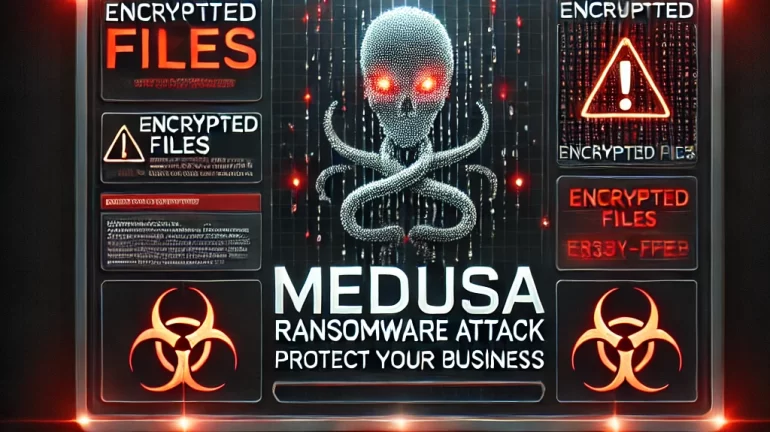
📅 Published by We Do IT Consultants | Cybersecurity Insights
⚠️ What is Medusa Ransomware?
Medusa ransomware is a highly sophisticated malware strain that encrypts files and demands ransom payments, often threatening to leak stolen data if victims refuse to pay—a tactic known as double extortion.
Key Characteristics of Medusa Ransomware:
✔ Double Extortion – Encrypts data and threatens to publish stolen information.
✔ Ransom Demands – Vary significantly, with some exceeding millions of dollars.
✔ Targeted Sectors – Healthcare, education, finance, legal, and government institutions.
✔ Advanced Persistence – Uses sophisticated techniques to evade detection and disrupt recovery efforts.
With its ability to cripple business operations and pressure victims into paying hefty ransoms, Medusa ransomware has become one of the most dangerous cyber threats in 2025.
🚨 Recent Medusa Ransomware Attacks & Their Impact
Medusa ransomware has been linked to multiple high-profile cyberattacks in 2025, causing financial and operational damage worldwide.
📅 Healthcare Provider Breach
🔴 Impact: A major hospital network experienced a complete IT shutdown after Medusa ransomware encrypted patient records. Medical operations were delayed, and patient data was threatened with public exposure.
📅 Global Manufacturing Shutdown
🔴 Impact: A multinational manufacturing firm suffered major production disruptions due to encrypted systems. The attackers initially demanded a multi-million-dollar ransom, increasing the pressure with data exposure threats.
📅 Government Agency Attack
🔴 Impact: A state government’s infrastructure was compromised, disrupting public services and leading to classified data theft. Investigations revealed attackers exploited outdated security protocols.
These incidents highlight Medusa ransomware’s ability to disrupt industries, compromise sensitive data, and pressure victims into ransom payments.
🛑 How Medusa Ransomware Infiltrates Businesses
Medusa ransomware operators employ multiple attack vectors to breach corporate networks. Businesses must understand these methods to strengthen their defenses.
📧 Phishing Emails & Social Engineering
- Cybercriminals send highly convincing emails with malicious attachments or links.
- Clicking the link or opening an infected file downloads Medusa ransomware onto the system.
✅ Prevention: Train employees on phishing awareness and deploy advanced email filtering solutions.
🌐 Exploiting Unpatched Software & Weak Passwords
- Hackers exploit security flaws in outdated applications to gain unauthorized access.
- Weak passwords allow cybercriminals to brute-force their way into accounts.
✅ Prevention: Enforce multi-factor authentication (MFA) and implement automated patch management.
🔌 Remote Desktop Protocol (RDP) Attacks
- Cybercriminals brute-force weak RDP credentials to gain system access.
- Once inside, they disable security controls before launching Medusa ransomware.
✅ Prevention: Restrict RDP access, enforce strong authentication measures, and use Zero Trust security policies.
🦠 Malware & Supply Chain Attacks
- Attackers infect software vendors, spreading Medusa ransomware through trusted software updates.
- Businesses unknowingly install compromised applications, leading to a widespread attack.
✅ Prevention: Regularly audit third-party software providers and deploy real-time malware detection solutions.
🛡️ How to Protect Your Business from Medusa Ransomware
1️⃣ Implement Zero Trust Security
🔹 Assume no user, device, or system is trusted by default.
🔹 Require continuous identity verification before granting access.
2️⃣ Deploy AI-Powered Threat Detection
🔹 Use behavioral analytics to detect ransomware before encryption begins.
🔹 Deploy AI-driven security solutions to identify anomalous activity.
3️⃣ Enable Advanced Endpoint Protection (EDR/XDR)
🔹 Prevent malware execution with real-time endpoint detection & response (EDR/XDR).
🔹 Monitor network traffic for suspicious behaviors and block unauthorized changes.
4️⃣ Strengthen Data Backups & Recovery Strategies
🔹 Maintain offline and immutable backups to prevent encryption by ransomware.
🔹 Regularly test backup restoration procedures to ensure data integrity.
5️⃣ Conduct Regular Security Awareness Training
🔹 Employees are often the weakest security link—train them to identify threats.
🔹 Simulate phishing attacks to measure awareness and response rates.
🚀 What to Do If Medusa Ransomware targets Your Business
🔴 1. DO NOT Pay the Ransom – Paying does not guarantee file recovery and encourages further attacks.
🔴 2. Disconnect Infected Systems – Isolate affected devices to prevent ransomware spread.
🔴 3. Contact Cybersecurity Experts & Law Enforcement – Work with incident response teams to mitigate the attack.
🔴 4. Restore from Backups – Use secure, offline backups to recover encrypted files.
🔴 5. Conduct Post-Incident Analysis – Fix vulnerabilities and strengthen security controls to prevent future breaches.
📌 Fact: Businesses that pay the ransom have a 60% chance of being attacked again within six months.
🔹 Final Thoughts: Medusa Ransomware Is Evolving—Is Your Business Prepared?
Medusa ransomware remains one of the most destructive cyber threats of 2025, leveraging data encryption, extortion, and advanced attack techniques to cripple businesses.
With the increasing sophistication of ransomware attacks, businesses must take a proactive cybersecurity approach.
At We Do IT Consultants, we provide:
✔ Ransomware defense strategies tailored to your industry.
✔ 24/7 threat monitoring with AI-driven security solutions.
✔ Zero Trust security implementation for maximum protection.
📩 Want to secure your business against ransomware threats? Contact us today!
🔗 Schedule a Free Cybersecurity Assessment
🚀 Stay Ahead. Stay Secure.
#CyberSecurity #MedusaRansomware #ThreatDetection #RansomwareProtection #ZeroTrust #WeDoIT

